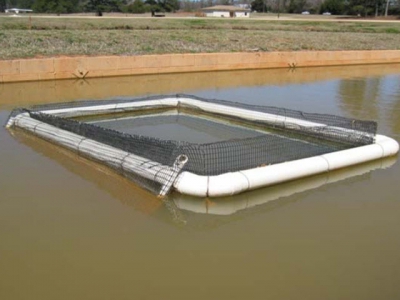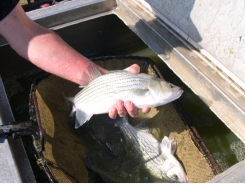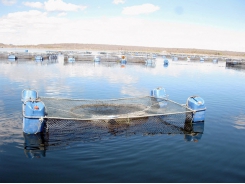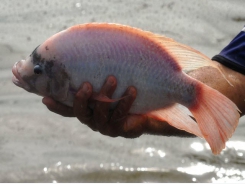Managing Cage Culture Systems

Definition
Fish may be produced at high density in cages suspended in private ponds or in State waters. Most aquaculture species can be produced in cages, but in Alabama, production has been limited mainly to tilapia (Oreochromis spp.) and channel catfish (Ictalurus punctatus). Fish in cages are provided feed one or more times per day. All uneaten feed and metabolic wastes enter the water body in which the cages are suspended. Fish are harvested from cages without draining water bodies.
Explanation
Cages usually are made of a rigid frame covered with a mesh material through which water can readily flow but fish cannot escape. Many types of non-corrodible mesh material can be used to include certain types of wire, plastic coated wire, nylon, plastic, etc. Cages may vary in size from about 30 or 40 ft3 to several hundred cubic feet. Two types of small cages are shown in Figure 1. Cages in freshwater usually are suspended by floats, but completely submersible cages may be used in the ocean.
The advantage of cage culture is that fish can be confined to facilitate feeding, harvesting, and other management procedures. When cages are installed in private ponds, fish can be harvested without draining ponds, and the environmental issues related to production are mainly the possibility of pollution of surface water by intermittent pond spillway flow following rainfall events. When cages are placed in State waters, there is no way of handling resulting wastes. Thus, cage culture in State waters has the greatest potential of all aquaculture production systems to cause pollution. Fish in cages are crowded and disease is a major threat. Thus, care should be exercised to use good practices to avoid disease outbreaks which could spread to fish outside cages. Also, dead fish should be promptly removed from cages and disposed in a responsible manner according to NRCS technical standards and guidelines.
Cage culture operation Practices
For cage culture in private ponds, applicable practices related to location, construction, maintenance, and management of ponds from Aquaculture Best Management Practice (BMP) Nos. 1-15 should be applied. In addition, the following practices apply specifically to cages:
• Management plans should be prepared by and practices implemented with the assistance of a professional engineer (PE) licensed in the State of Alabama or other qualified credentialed professional (QCP). Periodic inspections of the operation also should be conducted by a PE or QCP.
• The cages should be designed to allow detection or observation of uneaten feed falling through the mesh and to prevent accumulation of this waste on the bottom of the waterbody.
• When cages are removed from the pond for cleaning onshore, the debris removed from cages is not allowed to discharge directly into State waters.
• Dead fish should be removed promptly from cages and disposed by sanitary methods using NRCS technical standards and guidelines.
When cages are placed in State waters, the three practices mentioned above for cages should be applied along with additional practices as follows:
• Cages should be placed in areas with good water circulation.
• Cages should be moved about 300 ft at least once each growing season to protect sediment quality. Any sediment that is removed should be disposed in a responsible manner according to NRCS technical standards and guidelines.
• Measures must be taken to minimize the potential escape of non-native species.
• Feed should be stored in a responsible manner.
• Feed bags and other solid wastes should be disposed of in a responsible manner.
• Therapeutic agents should be used according to product labels.
• Cages should not interfere with navigation or other permissible water uses.
Cage aquaculture operations that are classified as concentrated aquatic animal production (CAAP) facilities must comply with EPA effluent limitation guidelines for net pen systems, applicable NRCS technical standards and guidelines, and if required, ADEM NPDES permitting requirements.
Implementation notes
Observations of fish feeding activity can be made from above cages only if floating feed is used. If sinking feed is used, it will be necessary for a diver to go beneath cages to determine if uneaten feed is accumulating on the bottom.
Cages usually are cleaned on land with brushes and jets of water. Cleaning wastes should be diverted into a sanitary sewer where possible, into a sedimentation pond, or other effective treatment system. Where cage culture is practiced in private ponds, cleaning wastes could be discharged into the culture pond. However, the discharge of untreated cleaning wastes to State waters is prohibited.
It is not feasible to treat wastes from cages in State waters. The main precaution against pollution is to locate cages in open water areas where water circulation is good. This will favor transport of wastes away from cages and rapid mixing and dilution of wastes by the water body. The distance between cage bottoms and the bottom of water bodies should be at least 4 to 6 ft to promote water movement beneath cages.
Multiple cages in a particular location obviously can increase the likelihood of pollution. While there are no specific guidelines for the number of cages that can be safely installed at a particular site, the location and configuration of cages should be accomplished with the assistance of an experienced QCP.
In bodies of water that stratify thermally, too many cages can result in severe organic enrichment and dissolved oxygen depletion in the hypolimnion. Sudden thermal de-stratification can result in dissolved oxygen depletion throughout the water column. This phenomenon has been responsible for serious mortality of fish both inside and outside of cages.
Wastes may accumulate beneath cages and cause deterioration of sediment quality. This is environmentally undesirable, but it also can have negative impacts on the fish in cages. Sediment quality in areas where cages are located can be protected by periodically moving cages a distance of at least 300 ft to a position where sediment quality has not been recently impacted by cages. Observations on sediment quality could be used to determine when to move cages, but there are no easy ways of evaluating sediment quality. Thus, cages probably should be moved after each crop of fish or at a minimum of 6 to 8 month intervals. Relocating cages will prevent sediment under them from reaching a severe stage of impairment and allow its quality to improve.
It is not possible to assure that fish will not escape from cages. Cages should be of sturdy material and maintained in a good condition to minimize the likelihood of holes and rips through which fish can escape. It is particularly important to use cage material that does not corrode, as holes may appear suddenly and without warning in cages made of corrodible wire. Cages should be placed in areas where there is little danger of collisions with boats or floating debris and heavy waves are not likely to damage them. Placement of cages in navigable waters may need approval from the U.S. Coast Guard and/or permit, coverage from the U.S. Army Corps of Engineers. Cages should also be located as far as possible away from discharge outfalls form industries, municipal treatment plants, obvious urban stormwater runoff collection systems, and other potential pollutant sources, or in areas with increased potential for accidents or spills.
Feed storage should be according to BMP No. 7. Feed bags and solid wastes should be disposed of by procedures recommended in BMP No. 14. Use of therapeutic agents should conform to practices listed in BMP No. 11. Dead fish should be disposed according to BMP No. 13. Chlorides concentrations and saline water management is considered in BMP No. 16.
Figure 1. Two types of small fish cages.


Related news
Tools

Phối trộn thức ăn chăn nuôi

Pha dung dịch thủy canh

Định mức cho tôm ăn

Phối trộn phân bón NPK

Xác định tỷ lệ tôm sống

Chuyển đổi đơn vị phân bón

Xác định công suất sục khí

Chuyển đổi đơn vị tôm

Tính diện tích nhà kính

Tính thể tích ao




 Algae meals may support growth, body condition in…
Algae meals may support growth, body condition in…  Channel Catfish Virus Disease
Channel Catfish Virus Disease